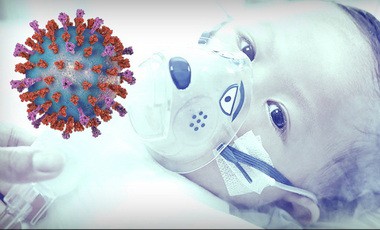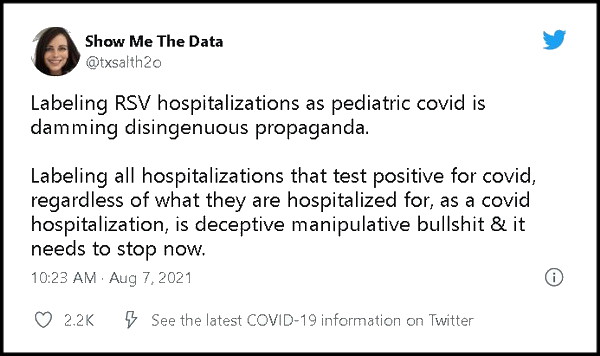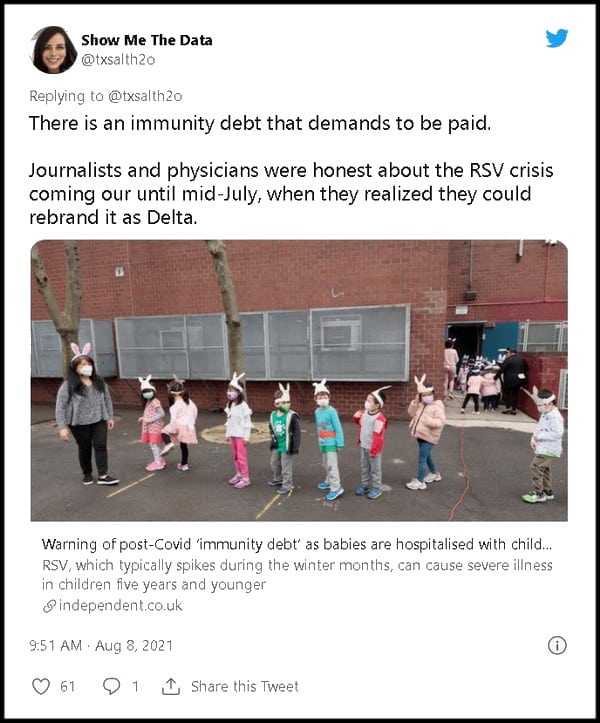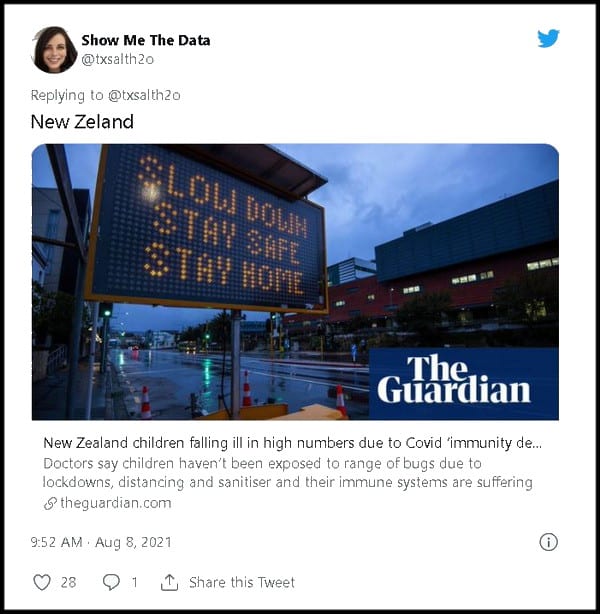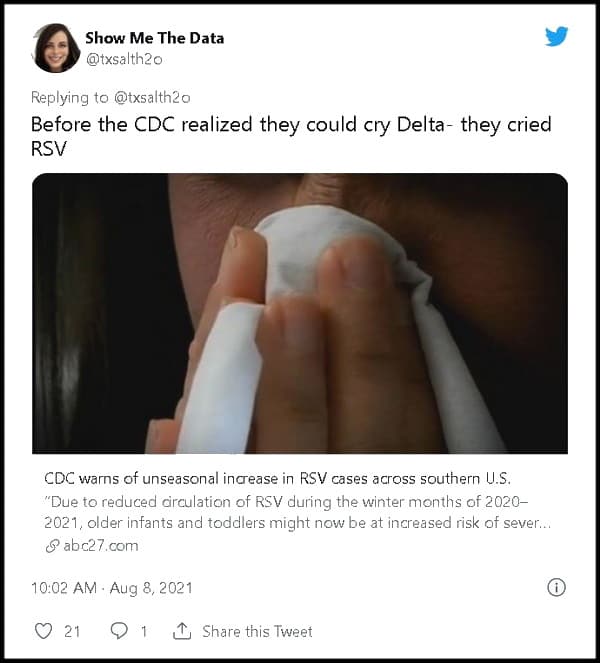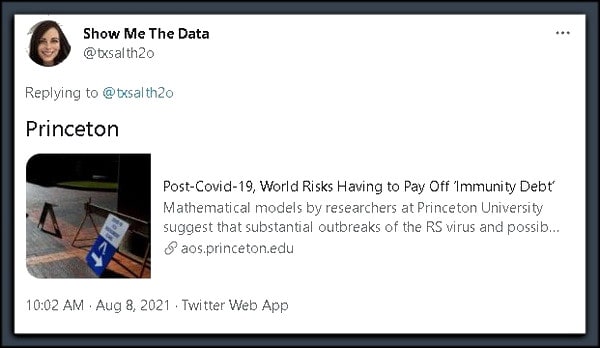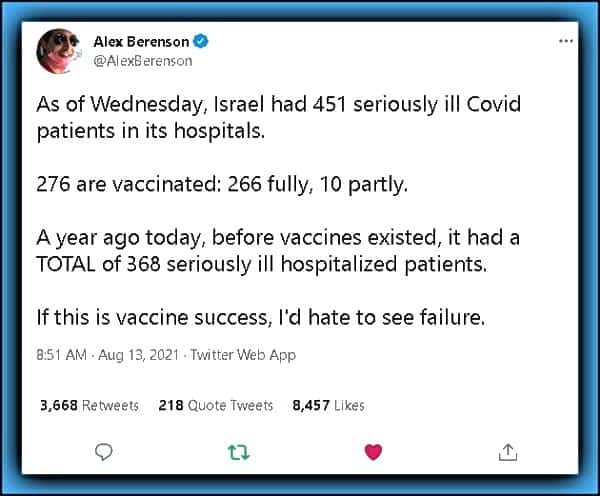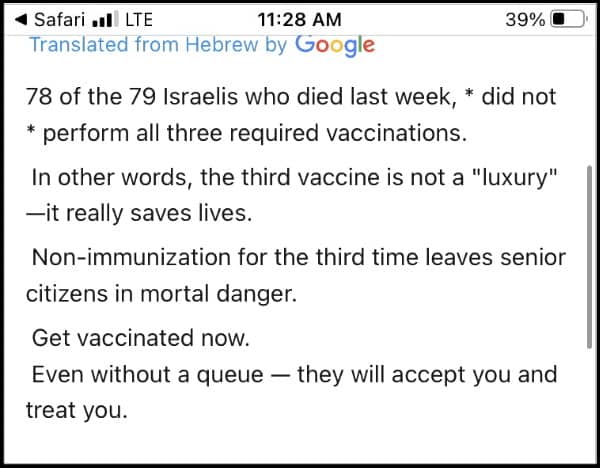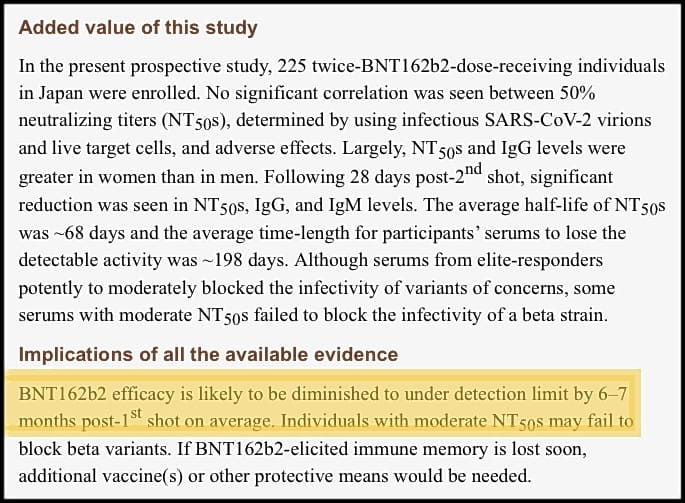- Jump to the Respiratory Syncytial Virus (RSV) portion
- Jump to the Messenger conversation
- Jump to the Fully Vaxed stats from Israel
Okay, to follow are two stories that are “in-additions” to these to show just how manipulated and wrong the press has bee and has already had to backtrack on… but it doesn’t matter because people only remember the headlines, not the retractions or challenges. Again, the two new additions will follow the links:
The RSV story has a lot to do with hospitalizations and ICU beds. I will MAROOON the related stories:
- Some Israeli “Fully Vaccinated Patients” Update
- MORE Media Retractions… and Fact-Checks by NPR??
- The Texas Tribune Makes Glaring Hospitalization Mistake
- Natural Immunity Better than Vaccinations (#Science)
- Delta Variant vs. Chicken Pox | Conflating Two Categories
- CDC Dir. Rochelle Walensky Admits Truth About Death Numbers
- Hospitals Overwhelmed (Bonus: Florida Follies)
- Covid and Vaccine Updates and News Stories
- Is The Delta Variant Bad? Should We Mask Up For It?
Okay, from the CDC having to retract Florida numbers to CNN using numbers from a leftie paper that were 4,100% wrong to this RDV thing being glommed on to by the media as Covid admissions… the facts TRUMP the rhetoric of the Left.
This first story deals with the RSV topic via RIGHT SCOOP! (Apologies to RS for gabbing most of the post) — I AM ADDING THE BULLET POINTS:
I mean, your instinct is probably to answer “of course they are!” But there is misleading and then there’s MISLEADING. And in the second misleading, I’m talking about downright, outright, deliberately stating things in a way specifically to make it seem like you are saying ONE thing when actually you’re avoiding saying that ONE THING.
You know, it’s misleading to say that “most people hated that song” if only 51% of people hated that song. It’s sort of true but you’re leading people to believe it’s a bigger number.
But it’s MISLEADING to report “Hospital beds are filling up as Covid cases increase in Texas”, when your article is about how multiple factors are contributing to a bed shortage. You are deliberately giving the ILLUSION that you’ve said Covid cases are filling up the beds. But you actually aren’t saying that. You just want people to THINK you said it and not check further.
It was misleading of Anthony Fauci to say “masks are the most effective barrier to infection” when what he MEANT was “don’t buy too many masks we want them for other stuff.” (By the way, it’s quite an accomplishment on Fauci’s part that he was for AND against masks and was lying about their effectiveness in BOTH cases.)
Anyway, here’s what brought this up. [Link to ALLIE, link to AMANDA]
Those anecdotal tweets are interesting and telling. This is even more so:
This is damning:
- The United States is not the only country experiencing a spike in RSV cases. New Zealand has also reported an increase in children falling ill with the respiratory virus. The country has reported nearly 1,000 RSV cases in the past five weeks, according to the Institute of Environmental Science and Research. In infants younger than six months, RSV can cause symptoms like irritability, poor feeding, and apnea. Older infants and young children can experience a decreased appetite before having a cough, fever, and wheezing. In the health advisory, the CDC said the RSV spike deviated from a typical circulation pattern for the virus, so it was not possible for the agency to anticipate the spread, peak, or duration of viral activity. (INDEPENDENT)
- New Zealand hospitals are experiencing the payoff of “immunity debt” created by Covid-19 lockdowns, with wards flooded by babies with a potentially-deadly respiratory virus, doctors have warned. Wellington has 46 children currently hospitalised for respiratory illnesses including respiratory syncytial virus, or RSV. A number are infants, and many are on oxygen. Other hospitals are also experiencing a rise in cases that are straining their resources – with some delaying surgeries or converting playrooms into clinical space. RSV is a common respiratory illness. In adults, it generally only produces very mild symptoms – but it can make young children extremely ill, or even be fatal. The size and seriousness of New Zealand’s outbreak is likely being fed by what some paediatric doctors have called an “immunity debt” – where people don’t develop immunity to other viruses suppressed by Covid lockdowns, causing cases to explode down the line. (GUARDIAN)
And this on CDC is devastating.
- TAMPA, Fla. (WFLA) – The Centers for Disease Control and Prevention issued a health advisory after seeing an increase in Respiratory Syncytial Virus, more commonly known as RSV, across the southern United States. “Due to reduced circulation of RSV during the winter months of 2020–2021, older infants and toddlers might now be at increased risk of severe RSV-associated illness since they have likely not had typical levels of exposure to RSV during the past 15 months,” a release from the CDC said. Doctors across Tampa Bay say RSV typically spreads in the winter months, like the common cold. However, they have been seeing an increase in cases in the last few months, as temperatures warm, which is unusual. “It is the predominant thing we are seeing in the emergency department right now,” said Dr. Joseph Perno, the chief medical officer for John’s Hopkins All Children’s Hospital in St. Petersburg, Florida. (ABC 27 NEWS TAMPA)
Breaking away from RIGHT SCOOP, I will continue the graphics with links to their Twitter — which you can then link to the articles from:
- Mathematical models by researchers at Princeton University suggest that substantial outbreaks of the RS virus and possibly seasonal flu may occur in future years (link is external), with peak outbreaks likely occurring in the 2021-2022 winter season in the U.S. (PRINCETON)
That linked to a WALL STREET JOURNAL Article, which follows:
Post-Covid-19, World Risks Having to Pay Off the ‘Immunity Debt’
Many people had little exposure to common viruses during social distancing, meaning bugs could spread more quickly once countries reopen
Doctors in France are calling it the immunity debt: When people avoided each other during the pandemic, they failed to build up the immunity against viruses that comes from normal contact.
As regular life resumes, society may find payments on that debt coming due, in the form of worse-than-normal viral disease outbreaks.
In early June, 16-month-old Toranosuke Tsukidate came down with a common virus that caused a fever topping 106 degrees Fahrenheit.
The bug was spreading rapidly through his Tokyo daycare, said his mother, Miwako Tsukidate, 27, and the boy was hospitalized for oxygen treatment for a week.
By the time Toranosuke was discharged, his mother observed the beds around him filling up with children suffering the same ailment, which is usually more common in the fall.
“I was surprised to see how it took off so quickly, and I was also surprised to see it spreading at this time of the year,” Ms. Tsukidate said.
At Perth Children’s Hospital in Australia, infectious diseases researcher David Foley isn’t surprised.
His country experienced a similar out-of-season flare-up of the virus that infected Toranosuke — respiratory syncytial virus or RS virus — during the Southern Hemisphere’s summer months following an unusually quiet winter.
There was “an increased population that was susceptible, helping the virus to spread more easily,” Dr. Foley said. “Similar to starting a fire, the more kindling present, the easier it is for a spark to take hold and burn brightly.”
Doctors around the world who treat infections are getting ready for another year or two full of such anomalies.
As people strove to avoid the virus that causes Covid-19, they ended up staying away from many other viruses and bacteria that cause common ailments — influenza, chickenpox, strep throat, RS virus and more. Now as normal life resumes in many countries, exposure to those bugs is returning, too.
RS virus, transmissible by droplets and contact with contaminated surfaces, is usually minor in children but occasionally leads to hospitalization. Because it can cause inflammation of small airways in the lungs, it is also a significant cause of death in the elderly.
At Maimonides Children’s Hospital in Brooklyn, N.Y., Rabia Agha, director of the pediatric infectious diseases division, encountered an RS virus wave this spring.
She found the median age of infants treated was just 6 months, down from 17 months the previous season. The immune system of small babies tends to be weaker, so more of this year’s patients ended up in intensive care.
Dr. Agha thinks the difference had to do with mothers not being exposed to the virus while pregnant.
Mothers pass on RS virus antibodies to their babies but only when they have had a recent infection, she said.
Since May, the number of cases has eased, but “RSV will definitely come back and attack a larger population because last season few children got infected,” Dr. Agha said.
Toranosuke’s pediatrician, Akifumi Tokita, said older toddlers, age 3 or 4, were also turning up with high fevers because of RS virus.
He attributed this to their lack of normal exposure to the virus, which in turn meant they couldn’t build up immunity little by little.
In the U.S., the Centers for Disease Control and Prevention issued a warning in early June about increased cases of the virus in the South after a year of low activity. The U.K., France and Japan have also seen a return of RS virus.
Figures recently released in Japan show the profound effect exposure to viruses such as flu and RSV can have on a nation’s health.
Deaths caused by pneumonia — a common complication of viral infections — last year in Japan fell by more than 17,000, far outweighing the 3,466 deaths attributed to Covid-19. As a result, Japan’s overall mortality fell for the first time in more than a decade.
It may have been borrowing from the future by creating greater room for viruses to run rampant later.
Robert Cohen, a professor at a pediatric research center near Paris called Activ, calls this “immunity debt.”
Dr. Cohen said the hygiene measures adopted during the pandemic bring “an immediate and indisputable benefit” because common illnesses have been suppressed.
But at some point almost all children are going to get RS virus, chickenpox and viruses that cause colds, which could mean larger outbreaks when the bugs make up for lost time, he said.
Mathematical models by researchers at Princeton University suggest that substantial outbreaks of the RS virus and possibly seasonal flu may occur in future years, with peak outbreaks likely occurring in the 2021-2022 winter season in the U.S.
Dr. Cohen said another long-term concern involves the hygienist theory, which suggests that modern cleanliness contributed to the rise in allergies in wealthier countries by hindering the development of children’s immune systems.
With Covid-19 lockdowns, “We may see more children with allergic asthma,” he said.
Other doctors said they considered such an effect unlikely after only a year of social distancing.
Stopping a resurgence of infections during post-Covid-19 times depends in part on vaccinations.
Common viral diseases including chickenpox, rotavirus or stomach flu and regular flu can be prevented through vaccines. However, no vaccine for RS virus is available. The World Health Organization has said developing one is a priority.
Dr. Foley, the researcher in Perth, said he hoped the new technologies behind the Covid-19 vaccines “will spill over and help us develop more effective RSV vaccines.”
For now, people have one powerful tool that doesn’t depend on a medical breakthrough. “You can get rid of a lot of viruses by good hand-washing,” said Brooklyn’s Dr. Agha.
That is the hospitalization of kids issue. Next is an update the fully vaccinated in Israel. However — FIRST — just a quick convo I had with a friend via MESSANGER:
QUICK CONVO
RT: Of course this is a “Pandemic of the Unvaccinated.” Numbers are impossible to refute. Feel sorry for the little kids that are getting beat up by this thing, even though those numbers are small. You always find that “one doctor.” Usually the oddballs.
ME: I refute em all day long on my site. CDC had to retract Florida numbers. CNN used numbers from a leftie paper, and retracted because the # was in the 700s, and not 5,800. RSV is blowing up in kids, media is saying Covid. Don’t be silly
RT: I’ll agree with you and we can both be wrong. ICU beds tell EVERYTHING. Louisiana in big trouble. Florida and Texas big cities already in trouble.
ME: ICU beds not due to covid. Sorry. Also, not anywhere near a pandemic, at all. The flu season of 2017-2018 much worse. Also ……
STILL ME: Not only that, but if you catalogued that flu season (2017-2018) with the new definitions per the CDC (April of 2020) that flu season would have tripled to quadrupled in deaths attributed to it.
(AFTER THOUGHT): What my friend is doing is combining all the stats in his head from the start of this in September of 2019. Instead, he should be looking at this as two separate seasons and working with those numbers to compare with: 2019-2020 and 2020-2021.
END
Okay, moving on. Again, this is only half of a post via ALEX BERENSON, who, like the WSJ is behind a partial pay wall. But his posts have been key — for quite some time now. Enjoy the deep thought/work of Alex:
Yesterday Naftali Bennett, the prime minister of Israel, issued an stark (if unintentionally) revealing warning to his country about the failure of the mRNA vaccines.
As you know if you are a regular reader, Israel is the canary in the world’s coalmine for Covid and the vaccines. It vaccinated more of its citizens with the Pfizer shot more quickly than almost anywhere else.
This spring, Israel’s experience seemed to validate the success of the vaccines. Now it’s a cautionary tale, as I explained in a Substack almost two weeks ago (time flies when nations are falling).
Unfortunately since then the data has gotten much worse.
The number of serious cases has risen almost 30-fold since late June. Roughly 60 percent of those people are fully vaccinated.
Yet the vaccine fanatics refuse to admit the depth of Israeli the crisis. Instead they continue to point out that per-person rates of serious illness are higher in the unvaccinated elderly.
They are correct, but they’re leaving out a key fact. Over 90 percent of Israelis over 70 have been vaccinated, suggesting that many of the remainder have not received vaccinations because they are too frail to do so. (One datapoint supporting this fact: Vaccination rates actually peak among people in their seventies and then decline as people get older, even though the oldest people are at the highest risk and should be the most likely to be vaccinated.)
Thus the relative numbers matter much less than the absolute numbers and trend. And the absolute trend is awful.
—
Which brings us to what Naftali Bennett tweeted yesterday.
“Non-immunization for a third time leaves senior citizens in mortal danger. Get vaccinated now.”
Mortal danger?
Get vaccinated now?
These older Israelis are already vaccinated. Yet as Israel’s Covid wards, fill their prime minister is now more or less admitting that they are unprotected against the virus.
A major preprint out of Japan from July 30 explains why.
The researchers examined Pfizer vaccine-generated antibodies in more than 200 people and found that on average they fell to undetectable levels about 6.5 months after the first shot – or roughly five after they reach full vaccination.
In other words, the Israel failure is happening right on schedule. Vaccine protection lasts months, not years. (Four months, give or take, since protection is limited the first month and likely negative the first week or two.)
Thus Bennett’s desperate call for a third shot. But although the booster does seem to produce new antibodies, neither the Israeli government nor Pfizer nor anyone else can know whether it will reduce infections or deaths, either temporarily or permanently. NO ONE HAS CONDUCTED ANY CLINICAL TRIALS TO DETECT THESE ENDPOINTS OR TO EXAMINE THIRD SHOT SIDE-EFFECTS IN ANY DETAIL. (I looked at this issue last week in a different Substack.)…………….
Anyways, I am sure more will be available for review in the days to come.
